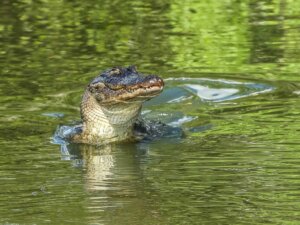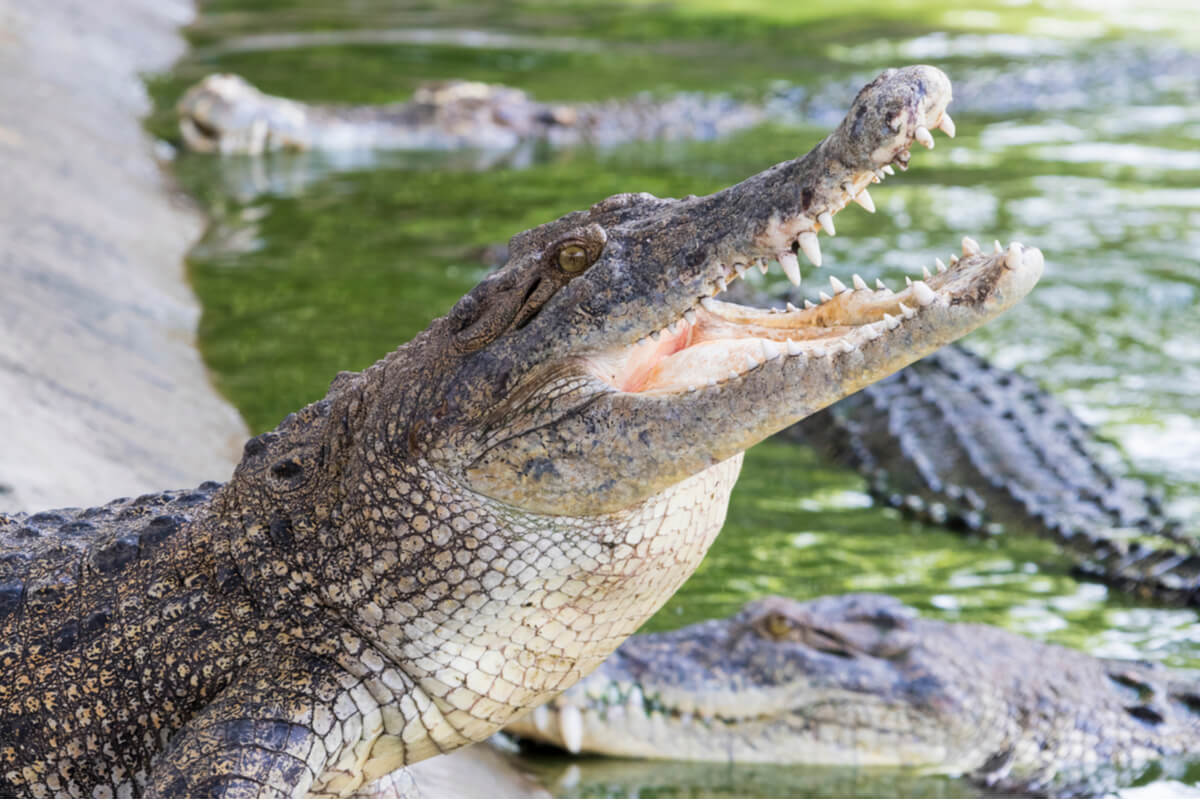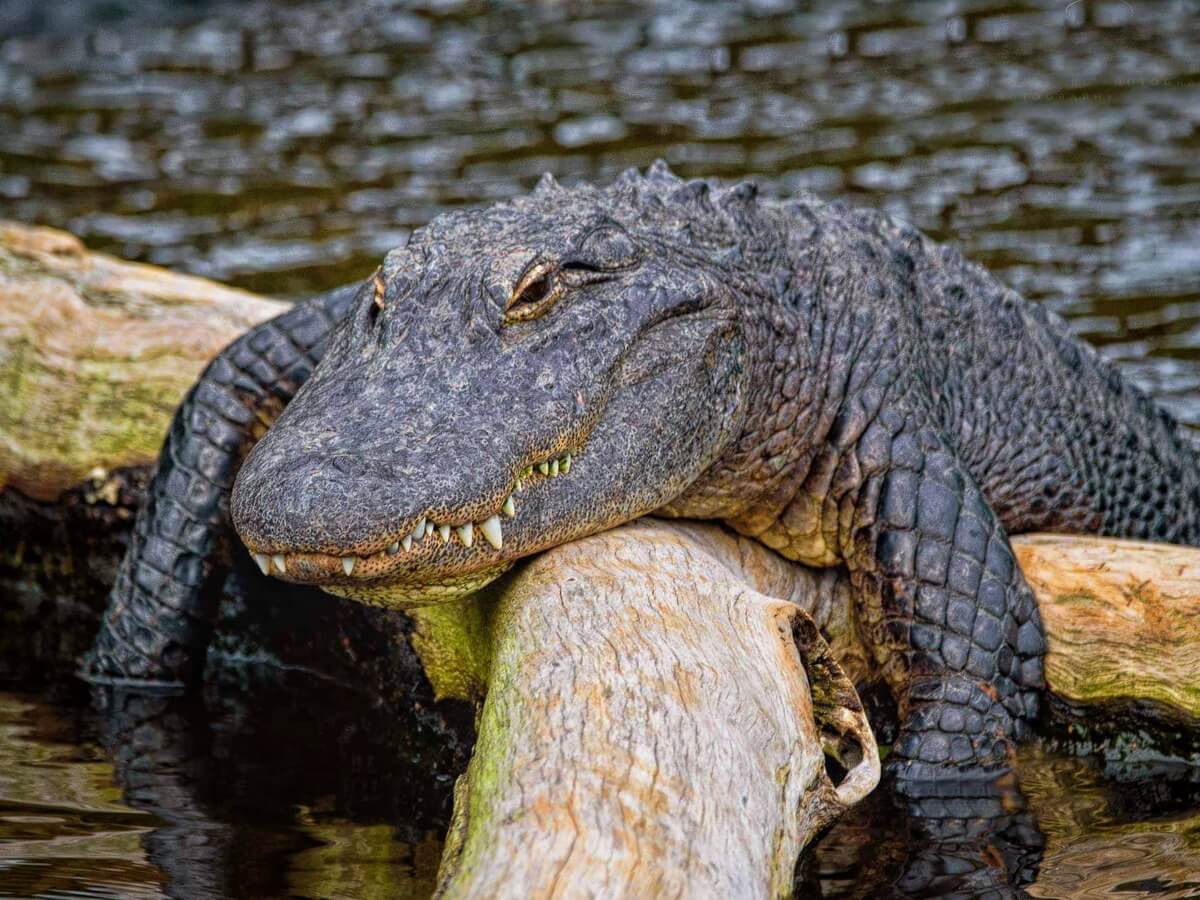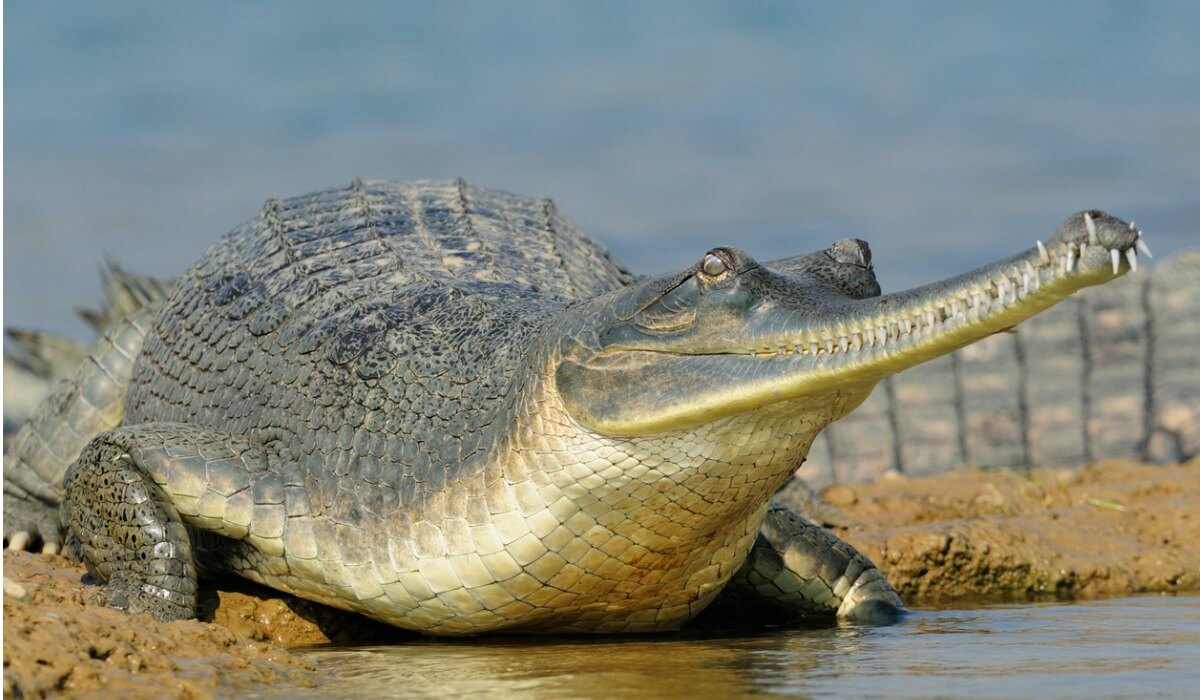The Differences Between Caimans and Crocodiles


Written and verified by the biologist Raquel Rubio Sotos
Reptiles are a group of amniotic vertebrates with epidermal keratin scales. This paraphyletic taxon encompasses more than 10,000 species and 2,700 subspecies, making it one of the most diverse along with fish and birds. Crocodilians are one of the most famous representatives of this group, but could you tell the differences between caimans and crocodiles?
These scaly reptiles are some of the oldest and all have aquatic habits and jaws ready to kill. If you want to learn to distinguish between caimans and crocodiles, you’re in the right place.
Caimans and crocodiles: scientific classification
Caimans and crocodiles belong to the animal kingdom and are included in the order Crocodylia. The protosuchios are the common ancestors of the entire order of crocodiles and caimans. Through adaptive radiation, these archaic reptiles gave way during the Cretaceous to the Eusuchians, a group that current crocodiles belong to.
These reptiles are part of the Archosauromorpha clade, along with birds, dinosaurs and pterosaurs. Many phylogenetic studies have been carried out to try to define the species and families of the order Crocodylia and controversy continues to exist when defining the current species.
The currently most accepted phylogenetic classification is the one that includes a total of 3 families, 23 species and two subspecies of the Crocodylia order. These families are Alligatoridae, Gavialidae, and Crocodylidae. Caimans (like alligators) belong to the Alligatoridae family and crocodiles to the Crocodylidae family.
The differences between the caimans and crocodiles are very succinct, as they’re close relatives.
Differences in size and color
When we talk about differences between caimans and crocodiles, the first to mention is that the crocodile is always larger than the caiman. As a general rule, this is the case, but the 23 species present must be taken into account, since their maximum size varies from 1.5 meters to 8 meters (5 – 26 feet) in the largest species, the marine crocodile (Crocodylus porosus).
Another problem as far as differentiating them by size occurs with the offspring, as, until they reach their full development, we won’t be able to tell which species is larger. Even so, as a general rule we can say that crocodiles are larger.
Regarding the coloration of the skin, this can vary between species and even between ecosystems, but the differences between caimans and crocodiles are minimal on this front. What we can better appreciate in crocodiles are the spots and dimples present on the ridges that caimans don’t have.

Differences in the oral cavity
The best way to differentiate an alligator from a crocodile is through its mouth:
- Crocodile mouth cavity: Crocodiles have a “V” shape and the fourth tooth of the lower jaw is always visible. This occurs because the crocodile’s jaws are practically the same size. Also, the teeth fit together.
- Caiman mouth cavity: The caiman’s snout is wider and has a “U” shape. The lower jaw is thinner than the upper jaw, so the teeth of the lower jaw aren’t visible. On the other hand, the fourth tooth in the lower jaw fits into a depression in the upper jaw and is never visible. The teeth overlap each other.
Habitat differences
To the naked eye, caimans and crocodiles live in the same type of habitat. All of them prefer water areas with beaches to be able to sunbathe, rest and breed. Although both occupy this type of territory, the crocodile has a greater distribution.
We can find crocodiles in America, Africa, Asia, and Australia and they can live in both fresh and salt water. This adaptation to salinity is only possessed by crocodiles and it’s thanks to saline glands, present on their tongue, that allows the elimination of excess salt from both water and food.
Caimans don’t have these regulatory glands, so they can’t live in salt water. Both families are found in areas close to the equator, as, being cold-blooded animals, they need a warm temperature to activate their metabolism.
Are there many similarities between caimans and crocodiles?
When we see a caiman and a crocodile we can see that, physically speaking, they’re very similar. Both are large reptiles, of the same order (Crocodylia), with flat and elongated but robust bodies, with a strong tail that’s usually longer than the trunk.
Both types of reptiles have a carnivorous diet and their habitat is very similar, as they all need bodies of water or beaches to survive. In addition, both caimans and crocodiles regulate their temperature by opening their jaws.

Alligators and the gharials
Alligators belong to the same family as caiman, but they do have some differences. There are only two species, the American alligator (Alligator mississippiensis) and the Chinese alligator (Alligator sinensis).
Alligators are larger than caimans and considerably more agile on land, reaching speeds of 30 km / h. It is also one of the few reptiles that generate some type of sound. In this case, it’s a roar, which is used both to intimidate and to attract females during the breeding season.
The gharials are another family (Gavialidae) and only comprise one species, the Ganges gharial (Gavialis gangeticus). It differs from caimans and crocodiles mainly by the jaws. Its snout is long and fine, it has even teeth along the entire jaw and it feeds exclusively on fish, making it a piscivore.
Also, behaviorally speaking, gharials spend much more time in the water.

This ancient and fascinating family never ceases to amaze. Perhaps future studies will change the number of species and their classification, but now we can distinguish caimans and crocodiles more easily thanks to these differences between them.
Reptiles are a group of amniotic vertebrates with epidermal keratin scales. This paraphyletic taxon encompasses more than 10,000 species and 2,700 subspecies, making it one of the most diverse along with fish and birds. Crocodilians are one of the most famous representatives of this group, but could you tell the differences between caimans and crocodiles?
These scaly reptiles are some of the oldest and all have aquatic habits and jaws ready to kill. If you want to learn to distinguish between caimans and crocodiles, you’re in the right place.
Caimans and crocodiles: scientific classification
Caimans and crocodiles belong to the animal kingdom and are included in the order Crocodylia. The protosuchios are the common ancestors of the entire order of crocodiles and caimans. Through adaptive radiation, these archaic reptiles gave way during the Cretaceous to the Eusuchians, a group that current crocodiles belong to.
These reptiles are part of the Archosauromorpha clade, along with birds, dinosaurs and pterosaurs. Many phylogenetic studies have been carried out to try to define the species and families of the order Crocodylia and controversy continues to exist when defining the current species.
The currently most accepted phylogenetic classification is the one that includes a total of 3 families, 23 species and two subspecies of the Crocodylia order. These families are Alligatoridae, Gavialidae, and Crocodylidae. Caimans (like alligators) belong to the Alligatoridae family and crocodiles to the Crocodylidae family.
The differences between the caimans and crocodiles are very succinct, as they’re close relatives.
Differences in size and color
When we talk about differences between caimans and crocodiles, the first to mention is that the crocodile is always larger than the caiman. As a general rule, this is the case, but the 23 species present must be taken into account, since their maximum size varies from 1.5 meters to 8 meters (5 – 26 feet) in the largest species, the marine crocodile (Crocodylus porosus).
Another problem as far as differentiating them by size occurs with the offspring, as, until they reach their full development, we won’t be able to tell which species is larger. Even so, as a general rule we can say that crocodiles are larger.
Regarding the coloration of the skin, this can vary between species and even between ecosystems, but the differences between caimans and crocodiles are minimal on this front. What we can better appreciate in crocodiles are the spots and dimples present on the ridges that caimans don’t have.

Differences in the oral cavity
The best way to differentiate an alligator from a crocodile is through its mouth:
- Crocodile mouth cavity: Crocodiles have a “V” shape and the fourth tooth of the lower jaw is always visible. This occurs because the crocodile’s jaws are practically the same size. Also, the teeth fit together.
- Caiman mouth cavity: The caiman’s snout is wider and has a “U” shape. The lower jaw is thinner than the upper jaw, so the teeth of the lower jaw aren’t visible. On the other hand, the fourth tooth in the lower jaw fits into a depression in the upper jaw and is never visible. The teeth overlap each other.
Habitat differences
To the naked eye, caimans and crocodiles live in the same type of habitat. All of them prefer water areas with beaches to be able to sunbathe, rest and breed. Although both occupy this type of territory, the crocodile has a greater distribution.
We can find crocodiles in America, Africa, Asia, and Australia and they can live in both fresh and salt water. This adaptation to salinity is only possessed by crocodiles and it’s thanks to saline glands, present on their tongue, that allows the elimination of excess salt from both water and food.
Caimans don’t have these regulatory glands, so they can’t live in salt water. Both families are found in areas close to the equator, as, being cold-blooded animals, they need a warm temperature to activate their metabolism.
Are there many similarities between caimans and crocodiles?
When we see a caiman and a crocodile we can see that, physically speaking, they’re very similar. Both are large reptiles, of the same order (Crocodylia), with flat and elongated but robust bodies, with a strong tail that’s usually longer than the trunk.
Both types of reptiles have a carnivorous diet and their habitat is very similar, as they all need bodies of water or beaches to survive. In addition, both caimans and crocodiles regulate their temperature by opening their jaws.

Alligators and the gharials
Alligators belong to the same family as caiman, but they do have some differences. There are only two species, the American alligator (Alligator mississippiensis) and the Chinese alligator (Alligator sinensis).
Alligators are larger than caimans and considerably more agile on land, reaching speeds of 30 km / h. It is also one of the few reptiles that generate some type of sound. In this case, it’s a roar, which is used both to intimidate and to attract females during the breeding season.
The gharials are another family (Gavialidae) and only comprise one species, the Ganges gharial (Gavialis gangeticus). It differs from caimans and crocodiles mainly by the jaws. Its snout is long and fine, it has even teeth along the entire jaw and it feeds exclusively on fish, making it a piscivore.
Also, behaviorally speaking, gharials spend much more time in the water.

This ancient and fascinating family never ceases to amaze. Perhaps future studies will change the number of species and their classification, but now we can distinguish caimans and crocodiles more easily thanks to these differences between them.
All cited sources were thoroughly reviewed by our team to ensure their quality, reliability, currency, and validity. The bibliography of this article was considered reliable and of academic or scientific accuracy.
Rodríguez, M. A. (2000). Cocodrilos (Archosauria: Crocodylia) de la Región Neotropical. Biota Colombiana, 1(2), 135-140.
Scheyer, T. M., & Sánchez-Villagra, M. R. (2012). Diversidad y Gigantismo en los Cocodrilos Fósiles. Venezuela Paleontológica, 245-258.
López-Luna, B. M. A. La conservación de los cocodrilos en México: conocimientos y estrategias.
This text is provided for informational purposes only and does not replace consultation with a professional. If in doubt, consult your specialist.








